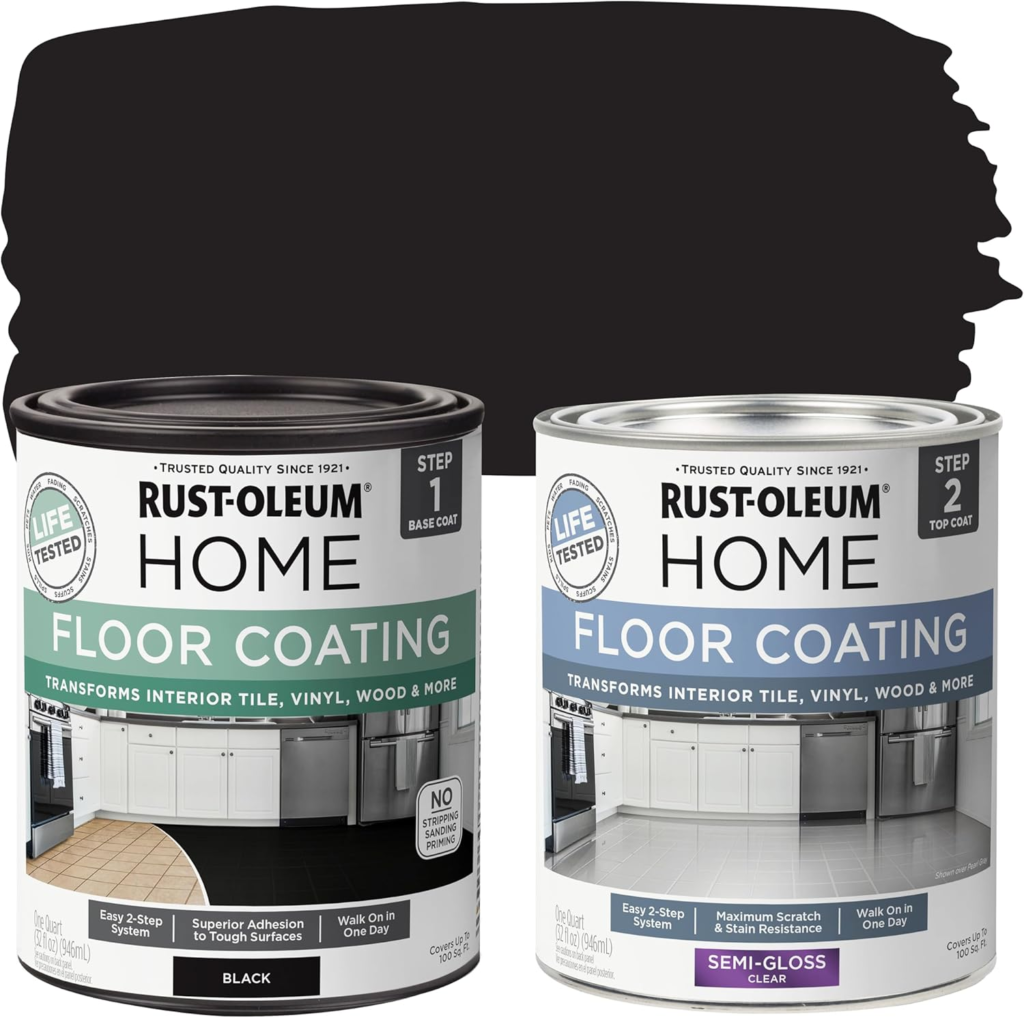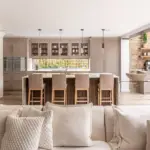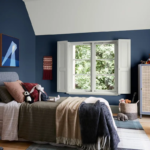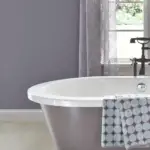Color drenching is a bold interior design trend where every surface in a room—the walls, ceiling, trim, and even sometimes furniture—is painted the same color. This technique eliminates visual distractions, creating a cohesive and immersive environment. It’s more than just a design choice; it’s a statement of personality and artistic expression.

Why Is It Trending?
In recent years, the desire for personalized and unique spaces has grown significantly. Color drenching offers a dramatic yet intimate ambiance, making it a favorite among homeowners and designers looking to transform ordinary rooms into extraordinary experiences. The trend has been fueled by social media, where visually striking interiors quickly gain attention, inspiring others to try it in their own spaces.

The Emotional Impact of Color Drenching
Creating Drama and Coziness
One of the most striking aspects of color drenching is its ability to evoke strong emotions. A deep blue room can feel like a comforting cocoon, while a vibrant green room might energize and invigorate. The uniformity of the color envelopes you, creating an almost theatrical experience that feels both dramatic and cozy.

How Colors Affect Mood
Colors play a powerful role in influencing mood and perception. Warm tones like blush pink or butter yellow can create feelings of happiness and comfort. Cool tones like green and blue evoke calmness and tranquility. Understanding how a color will make you feel is essential when choosing the shade for your color-drenched room.
Is Color Drenching Right for You?
Who Should Try It?
Color drenching is ideal for individuals who:

Pro Grade Paint Roller Kit, Brush & Roller for Professionals & Homeowners
Perfect for smooth finishes on your interior walls. Ideal for home improvement enthusiasts!
Buy Now on Amazon- Love bold design choices.
- Aren’t afraid of committing to a specific color for an extended period.
- Want to make a room feel cohesive and unique.
When to Avoid This Trend
If you’re someone who prefers a minimalist aesthetic, color drenching might feel overwhelming. Additionally, renters or those planning to move soon may find the time and financial investment impractical.
Understanding the Commitment
Time Investment
Color drenching isn’t a quick weekend project. Preparing surfaces, choosing the right paint, and applying multiple coats to ensure even coverage takes time.
Financial Considerations
The cost of paint adds up quickly, especially if you’re covering every surface in a room. Hiring a professional painter for intricate areas like ceilings and trim further increases the expense.
Commitment to the Color Choice
Choosing a single color for an entire room is a big decision. It’s essential to test shades in different lighting conditions to ensure you’ll love the result.

Rust-Oleum 367605 Home Interior Floor Coating Kit, Semi-Gloss Black
Ideal for updating outdated flooring at a fraction of the cost of replacement and adheres without stripping, sanding or priming.
Buy Now on AmazonExamples of Color Drenching
Soft Butter Yellow Room
This subtle approach to color drenching uses a pale yellow to create a warm, inviting space. The soft hue avoids overpowering the room while still making a statement.
Blush Pink Bedroom
A blush pink bedroom exudes sophistication without feeling too youthful. Pairing it with gold or neutral accents can elevate the look to feel modern and chic.
Light Celery Green Living Room
This fresh and natural shade works beautifully in living rooms. The green creates a calming atmosphere, making the space feel harmonious and balanced.
Sky Blue Office with Painted Cabinets
Sky blue is an energizing yet tranquil color, perfect for a workspace. Painting the cabinets in the same shade enhances the seamless effect, though it’s a commitment best suited for long-term projects.
Deep Blue Living Room
A deep blue living room feels luxurious and enveloping. It’s an excellent choice for creating a space where you can relax and unwind.
Moody Dark Green Bedroom
Dark green adds a sense of mystery and drama, making it perfect for a bedroom. It creates an intimate, restful retreat ideal for winding down after a long day.
Design Tips for Successful Color Drenching
Choosing the Right Color Palette
Not all colors are suited for drenching. Consider how the color interacts with the natural light in your space and how it complements your existing décor.
Incorporating Furniture and Décor
When everything in a room is a single color, furniture and accessories play a crucial role in breaking up the monotony. Textures, patterns, and materials like wood or metal can add depth and interest.
The Role of Lighting in Color Drenching
Importance of Layered Lighting
Lighting can make or break a color-drenched room. Proper illumination ensures the color looks vibrant without feeling overwhelming.
How to Create Ambient, Task, and Accent Lighting
- Ambient lighting: Overhead lights that provide general illumination.
- Task lighting: Lamps and fixtures for specific activities like reading or working.
- Accent lighting: Decorative lights that highlight features or create a warm glow, adding a cozy ambiance to the space.
Overcoming Commitment Fears
Starting Small: Ceiling or Trim Only
If you’re hesitant to dive into full color drenching, start small. Painting just the ceiling or trim in a bold color can give you a taste of the trend without overwhelming the space.
Testing Colors Before Full Application
Before committing, use sample pots of paint to test how the color looks at different times of the day. This step ensures you’ll love the final result.
Challenges of Color Drenching
Dealing with Large or Complicated Spaces
Color drenching in large or open-plan spaces can be challenging. Without clear boundaries, maintaining visual cohesion becomes tricky. For example, a living room that flows into a dining area may require careful planning to avoid abrupt transitions between color-drenched areas and neutral zones. Structural elements like beams, columns, or uneven walls can also complicate the process.
Maintaining the Painted Surfaces
Once completed, maintaining a color-drenched space requires attention to detail. Painted surfaces, especially in high-traffic areas, can show scuffs, marks, or dirt over time. Choosing durable, washable paint finishes, such as satin or eggshell, can help keep the room looking fresh. Regular touch-ups and proper cleaning methods will be essential for long-term upkeep.
Practical Advice for DIYers
Tools and Materials You’ll Need
If you’re tackling color drenching as a DIY project, here’s what you’ll need:
- High-quality paint in your chosen color and finish.
- Brushes and rollers of various sizes for walls, ceilings, and trims.
- Painter’s tape for clean edges.
- Drop cloths to protect furniture and flooring.
- Primer to ensure a smooth base.
- Sandpaper or spackling paste for surface preparation.
Step-by-Step Guide
- Plan Your Color Scheme: Choose a shade that complements your space and test it with samples on walls, ceilings, and trim.
- Prepare the Surfaces: Clean the walls, patch any imperfections, and sand down rough areas. Apply primer if necessary.
- Protect Surrounding Areas: Use painter’s tape and drop cloths to safeguard floors, furniture, and fixtures.
- Apply Paint Evenly: Start with the ceiling, followed by walls, trim, and other elements. Use multiple coats to achieve consistent coverage.
- Inspect and Touch Up: After the paint dries, examine the room for missed spots or uneven areas and fix them as needed.
Professional Help: When to Hire Experts
Benefits of Hiring Painters
Professional painters bring expertise and efficiency to the table, especially for complex projects. They have the skills to handle intricate details, high ceilings, or textured surfaces, ensuring a polished finish. Hiring experts also saves time and effort, particularly for larger spaces.
Cost Expectations
The cost of professional painting varies depending on room size, complexity, and location. On average, hiring painters for color drenching can range from $500 to $3,000 or more. While it’s an investment, the flawless results often justify the expense.
Color Drenching and Room Functionality
Best Rooms for This Technique
Color drenching works exceptionally well in rooms where you want to create a specific atmosphere:
- Bedrooms: Choose soothing tones like blush pink or moody dark green for a restful retreat.
- Living Rooms: Warm or deep shades like butter yellow or navy blue make the space feel cozy and inviting.
- Offices: Energizing colors like sky blue can boost productivity while maintaining a calming environment.
Spaces Where It’s Less Practical
Certain spaces may not suit color drenching due to their function or layout:
- Kitchens: The abundance of cabinets and appliances can interrupt the cohesive look.
- Bathrooms: High humidity can affect painted surfaces, especially on ceilings and trims.
- Hallways: Limited natural light can make darker colors feel oppressive.
Mixing and Matching Styles
Combining Color Drenching with Other Trends
Color drenching doesn’t have to stand alone. It pairs beautifully with other interior design trends:
- Biophilic Design: Add greenery to a color-drenched room for a natural, organic feel.
- Maximalism: Incorporate bold patterns and eclectic décor for a layered, dynamic look.
- Minimalism: Keep furniture and accents simple to let the color shine as the focal point.
Making It Work with Existing Décor
If you’re introducing color drenching into a pre-decorated room, consider how the color interacts with your current furniture, art, and textiles. Neutral or monochromatic pieces work best to enhance the uniformity of the space.
Inspirational Ideas for Every Room
Bedrooms, Living Rooms, Kitchens, and Beyond
- Bedrooms: Experiment with deep hues like forest green or rich plum for an intimate and luxurious feel.
- Living Rooms: Soft pastel shades like light celery green create a calming, family-friendly space.
- Kitchens: Try color drenching in a bold shade like coral on an accent wall and cabinetry for a playful twist.
- Bathrooms: Opt for a serene color like powder blue to create a spa-like retreat.
- Home Offices: Energize your workspace with a zesty yellow or calming lavender.
Each room offers an opportunity to showcase your personality through carefully chosen colors.
Final Thoughts and Engagement
Encouraging Experimentation
Color drenching is a bold trend that pushes the boundaries of traditional design. Whether you go all-in with a moody hue or start small with a single accent, the key is to embrace the creative process and have fun experimenting. The beauty of this technique lies in its versatility—it can be as subtle or dramatic as you like.
Inviting Reader Feedback
Have you tried color drenching in your home? Share your experiences and favorite color choices in the comments! If you’re considering it, what’s holding you back? Let’s discuss how to make this trend work for you!
















